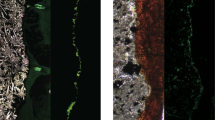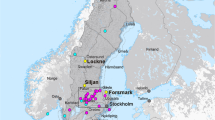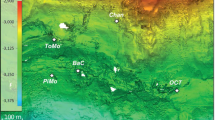Abstract
The recesses of the oceanic crust harbour microbes that influence geochemical fluxes between the solid Earth and the hydrosphere1,2. In the roots of the crust, mantle-derived rocks are progressively hydrated by hydrothermal circulation, a process known as serpentinization. The associated release of molecular hydrogen could provide metabolic energy for microbes3. Phylogenetic analyses of chimneys associated with seafloor hydrothermal systems have provided direct but spatially restricted evidence for the existence of active microbial communities in these hydrated rocks4; indirect evidence comes from isotopic analyses of drill cores5. Here, we examine fully serpentinized peridotites recovered from the Mid-Atlantic Ridge, using Raman microspectroscopy and electron microscopy. We detect high concentrations of organic matter, of two types, intimately associated with serpentine-hosted hydrogarnets. One type contains a complex mixture of aliphatic and aromatic compounds and functional groups such as amides, usually associated with biopolymers such as proteins, lipids and nucleic acids. The other corresponds to dense aggregates of thermally evolved carbonaceous matter, with a weak structural organization, which we attribute to the maturation of carbon compounds present in the other type of organic matter identified. We suggest that the observed endogenic accumulations of organic matter result from past microbial activity within the serpentinized oceanic crust, potentially supported by the by-products of serpentinization. We further suggest that the proposed crustal community mediates elemental fluxes from the Earth’s mantle to the oceans.
This is a preview of subscription content, access via your institution
Access options
Subscribe to this journal
Receive 12 print issues and online access
$259.00 per year
only $21.58 per issue
Buy this article
- Purchase on Springer Link
- Instant access to full article PDF
Prices may be subject to local taxes which are calculated during checkout




Similar content being viewed by others
References
Santelli, C. M., Edgcomb, V. P., Bach, W. & Edwards, K. J. The diversity and abundance of bacteria inhabiting seafloor lavas positively correlate with rock alteration. Environ. Microbiol. 11, 86–98 (2009).
Mason, O. U. et al. First investigation of the microbiology of the deepest layer of ocean crust. PLoS ONE 5, e15399 (2010).
McCollom, T. M. Geochemical constraints on sources of metabolic energy for chemolithoautotrophy in ultramafic-hosted deep-sea hydrothermal systems. Astrobiology 7, 933–950 (2007).
Kelley, D. S. et al. A serpentinite-hosted ecosystem: The Lost City hydrothermal field. Science 307, 1428–1434 (2005).
Alt, J. C. & Shanks, W. C. III Sulfur in serpentinized oceanic peridotites: Serpentinization processes and microbial sulfate reduction. J. Geophys. Res. 103, 9917–9929 (1998).
Peyve, A. A., Saveleva, G. N., Skolotnev, S. G. & Simonov, V. A. Tectonics and origin of the oceanic crust in the region of ‘dry’ spreading in the Central Atlantic (7 °10′–5°N). Geotectonics 37, 75–94 (2003).
Beard, J. S. & Hopkinson, L. A fossil, serpentinization-related hydrothermal vent, Ocean Drilling Program Leg 173, Site 1068 (Iberia Abyssal Plain): Some aspects of mineral and fluid chemistry. J. Geophys. Res. 105, 16527–16539 (2000).
Spötl, C. W., Houseknecht, D. & Jaques, R. C. Kerogen maturation and incipient graphitization of hydrocarbon source rocks in the Arkoma Basin, Oklahoma and Arkansas: A combined petrographic and Raman spectrometric study. Org. Geochem. 28, 535–542 (1998).
Maquelin, K. et al. Identification of medically relevant microorganisms by vibrational spectroscopy. J. Microbiol. Meth. 51, 255–271 (2002).
Andreani, M., Grauby, O., Baronnet, A. & Munoz, M. Occurrence, composition and growth of polyhedral serpentine. Eur. J. Mineral. 20, 159–171 (2008).
Kelemen, S. R. & Fang, H. L. Maturity trends in Raman spectra from kerogen and coal. Energ. Fuel. 15, 653–658 (2001).
Waples, W. D. & Marzi, W. R. The universality of the relationship between vitrinite reflectance and transformation ratio. Org. Geochem. 28, 383–388 (1998).
Fontaine, F. J., Cannat, M. & Escartin, J. Hydrothermal circulation at slow-spreading mid-ocean ridges: The role of along-axis variations in axial lithospheric thickness. Geology 36, 759–762 (2008).
Cannat, M., Fontaine, F. J. & Escartı´n, J. in Diversity of Hydrothermal Systems on Slow Spreading Ocean Ridge (eds Rona, P., Devey, C., Dyment, J. & Murton, B.) (Geophysical Monograph Series Vol. 188, AGU, 2010).
McCollom, T. M. & Seewald, J. S. Abiotic synthesis of organic compounds in deep-sea hydrothermal environments. Chem. Rev. 107, 382–401 (2007).
Proskurowski, G. et al. Abiogenic hydrocarbon production at Lost City hydrothermal field. Science 319, 604–607 (2008).
Pasteris, J. D. Secondary graphitization in mantle-derived rocks. Geology 16, 804–807 (1988).
Marshall, C. P., Edwards, H. G. M. & Jehlicka, J. Understanding the application of Raman spectroscopy to the detection of traces of life. Astrobiology 10, 229–243 (2010).
Snow, J. E. & Dick, J. B. Pervasive magnesium loss by marine weathering of peridotite. Geochim. Cosmochim. Acta 59, 4219–4235 (1995).
Chapelle, F. H. et al. A hydrogen-based subsurface microbial community dominated by methanogens. Nature 415, 312–315 (2002).
Kashefi, K. & Lovley, D. R. Extending the upper temperature limit for life. Science 301, 934 (2003).
Wankel, S. D. et al. Influence of subsurface biosphere on geochemical fluxes from diffuse hydrothermal fluids. Nature Geosci. 4, 461–468 (2011).
Marcaillou, C., Muñoz, M., Vidal, O., Parra, T. & Harfouche, M. Mineralogical evidence for H2 degassing during serpentinization at 300 °C/300 bar. Earth Planet. Sci. Lett. 303, 281–290 (2011).
Stupperich, E., Eisinger, H-J. & Schurr, S. Corrinoids in anaerobic bacteria. FEMS Microbiol. Lett. 87, 355–359 (1990).
Florencio, L., Field, J. A. & Lettinga, G. Importance of cobalt for individual trophic groups in an anaerobic methanol-degrading consortium. Appl. Environ. Microbiol. 60, 227–234 (1994).
Delacour, A., Früh-Green, G. L., Bernasconi, S. M., Schaeffer, P. & Kelley, D. Carbon geochemistry of serpentines in the Lost City hydrothermal system. Geochim. Cosmochim. Acta 72, 3681–3702 (2008).
Ehlmann, B. L., Mustard, J. F. & Murchie, S. L. Geologic setting of serpentine deposits on Mars. Geophys. Res. Lett. 37 http://dx.doi.org/10.1029/2010GL042596 (2010).
Sleep, N. H., Meibom, A., Fridriksson, Th., Coleman, R. G. & Bird, D. K. H2-rich fluids from serpentinization: Geochemical and biotic implications. Proc. Natl Acad. Sci. USA 101, 12818–12823 (2004).
Russell, M. J., Hall, A. J. & Martin, W. Serpentinization as a source of energy at the origin of life. Geobiology 8, 355–371 (2010).
Ljungdahl, L. G. A life with acetogens, thermophiles, and cellulolytic anaerobes. Annu. Rev. Microbiol. 63, 1–25 (2009).
Acknowledgements
We are grateful to A. Cipriani, who made available the sample collection recovered during the joint Russian–Italian S22 expedition from dredge site S2232, M. Ligi for providing the multibeam data and O. Boudouma for assistance during SEM. We thank F. Guyot, M. Andreani, A. Delacour, E. Galli, E. Passaglia, E. Gérard, M. van Zuilen and P. Philippot for discussion and support, along with N. H. Sleep for a constructive review. The authors have been funded by Fondazione Cassa di Risparmio di Modena through the CARBRIDGE project, the French CNRS-INSU INTERRVIE program (SERPECO project), an ECORD Research Grant 2010 to V.P. and the Région Ile de France (IPGP Raman facility). This is IPGP contribution 3241.
Author information
Authors and Affiliations
Contributions
All authors made the analyses, discussed the results and wrote the paper.
Corresponding authors
Ethics declarations
Competing interests
The authors declare no competing financial interests.
Supplementary information
Supplementary Information
Supplementary Information (PDF 676 kb)
Rights and permissions
About this article
Cite this article
Ménez, B., Pasini, V. & Brunelli, D. Life in the hydrated suboceanic mantle. Nature Geosci 5, 133–137 (2012). https://doi.org/10.1038/ngeo1359
Received:
Accepted:
Published:
Issue Date:
DOI: https://doi.org/10.1038/ngeo1359
This article is cited by
-
Microbial biosignature preservation in carbonated serpentine from the Samail Ophiolite, Oman
Communications Earth & Environment (2022)
-
Microbial interactions with silicate glasses
npj Materials Degradation (2021)
-
Iron-oxidizer hotspots formed by intermittent oxic–anoxic fluid mixing in fractured rocks
Nature Geoscience (2020)
-
Bacteria and archaea on Earth and their abundance in biofilms
Nature Reviews Microbiology (2019)
-
Abiotic formation of condensed carbonaceous matter in the hydrating oceanic crust
Nature Communications (2018)



